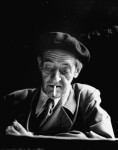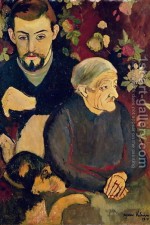
Maurice Utrillo
French , 1883-1955
Notre Dame Doree, 1911
oil and tempera on paper laid down on canvas
31 1/4 x 21 1/2 in.
SBMA, Bequest of Wright S. Ludington
1993.1.10

Photo of Maurice Utrillo writing, 1949.
“He is also a painter of the suburbs…. he loves the morose steeples of old churches, the deserted streets of the gloomy suburbs…. Maurice Utrillo evokes, above all, for every sensitive Parisian, the nostalgia of his native city, its sickly sky, its resigned houses.”
Louis Libaude wrote about Utrillo’s Blot Gallery show in 1913, under the pen name, Louis Lormel
RESEARCH PAPER
Born in Paris in 1883, Maurice Utrillo (pronounced OO-TREE_YO) is the illegitimate son of teenage French model and artist, Marie-Clementine Valadon, and, possibly, a young alcoholic painter named Boissy. A model for Renoir, Toulouse-Lautrec and other painters, Marie, at the urging of Lautrec, changed her first name to the more elegant “Suzanne”. It was Toulouse-Lautrec who introduced her to the great master, Degas. It was he who taught and encouraged her to paint. Suzanne Valadon married a prosperous businessman, Paul Mousis. Their friend, Miguel Utrillo, who lived in the often-painted Paris village of Montmartre, registered Maurice as his son but never entered the boy’s life. Maurice was a poor student in secondary school and dropped out by the age of sixteen. By eighteen he was failing as a bank clerk and had become an alcoholic. He was committed to an asylum, the first of many institutionalizations during his lifetime.
His doctor advised Suzanne to interest her son in painting as occupational therapy. Utrillo had already become interested in painting at around fourteen, though no paintings from this period exist. Utrillo grew up in Montmagny, a suburb of Paris—he loved the miserable streets and sad bistros of the suburbs. But often returned to the old picturesque and quiet artists’ quarter of Montmartre.
During his early years, 1904 to 1910 (the Montmagny or Impressionistic period), Utrillo’s painting steadily increased in popularity. However his bouts with alcoholism made him a poor manager of his talent and he often sold his paintings for the price of a meal or bottle of wine.
He often repeated subjects without dating them. Also, he used postcards so that one cannot be sure whether a given subject is painted from nature, from memory, or from a postcard. This doesn’t affect the quality of the image, nor is the use of the postcard detrimental. What is important is Utrillo’s interpretation of the subject. It is noted by other artists at that time that Utrillo had a remarkable visual memory. After studying a scene for two or three hours he could return to his studio and reproduce the entire scene from memory. He was prolific, and in his best years produced a masterpiece a day, often painting from memory or postcards during his frequent institutionalizations.
Utrillo had no formal training other than suggestions and encouragement from his mother (?). Elements of his paintings seem to assemble themselves at random. He often mixed plaster of paris in his paint to produce luminous whites to contrast with the rich dark browns and earthy greens. He loved the morose steeples of old churches and the deserted streets of the gloomy suburbs because they evoked nostalgia for his native city’s grey sky and resigned houses. His somber palette, utilized until about 1905, became influenced slightly by Impressionists in brushwork and color, though not in atmospheric effects. Known to use a palette knife, brush and fingers to manipulate the thick paint, his early period was similar to that of Pissarro, though it is generally felt that his style and color scheme developed independently.
Art historians divide Utrillo’s work into five periods: Impressionistic 1903-1907, Impasto 1907-1911, White 1911-1914, Architectural 1915-1919 and Colorful 1920 onward. After 1930 Utrillo’s work took on a repetitious quality using the same themes and producing inferior work.
A devout Catholic, Utrillo viewed wonderful Gothic religious edifices in a spirit of humility. A frontal view of a church nearly fills the entire canvas. Only a small area of gray dismal sky frames the church with the parishioners shown as small insignificant spots. The concrete gray sky, in contrast to the dark structure, creates a sense of space which adds to the three-dimensional quality of the church. The Cathedral has a sense of stability, solid and massive.
Notre Dame Doree shows a somewhat limited palette, but with many subtle and rich greens, browns and grays, similar to Pissarro and Braque. With only a few dabs of yellow and dark blue in the upper windows, the church appears especially dark and imposing on a typical gray Paris day. Utrillo’s technique shows the use of impasto with obvious brush strokes and palette knife work used to manipulate the thick paint. It is possible that the signature in the lower left corner was not done by Utrillo, but by his mother. His dealer at the time, Libaude, was dissatisfied with Utrillo’s usually large and heavy signature, often asking his mother to sign for him.
Many artists and critics regard Utrillo as one of the great urban painters of the century. Notre Dame Doree is a wonderful example of his ability to depict stability and serenity, though he was to have little of either in his life.
One must give cathedrals and churches an important place in his body of work. The most spectacular paintings are perhaps certain cathedrals which contain a true mystic power. “When Utrillo paints the imposing bulk of a basilica, or the pointed spire of a village chapel, he consciously expresses the love that man feels toward the Creator”.
Prepared for the Santa Barbara Museum of Art Docent Council by Stephen Hiatt, April 1994
Typed for the website by Jean McKibben Smith and edited by Lori Mohr, fall 2012
http://soufergallery.com/artists/utrillo-maurice/bio/ 2012 LG.

Portrait of Maurice Utrillo with Grandmother and his Dog, 1910 by his mother, Suzanne Valadon (1865 - 1938).
SBMA CURATORIAL LABELS
Utrillo was the illegitimate son of the woman artist, Suzanne Valadon. Perhaps inevitably, due to his mother’s thoroughly bohemian lifestyle in Montmartre, he suffered from alcoholism from the age of 18, which necessitated frequent stays at various spas and sanitariums to dry out. Nevertheless, painting was a form of therapy for Utrillo and he churned out many canvases
throughout his career, achieving sufficient critical fame to be awarded the Legion of Honor in 1928.
This unusual painting dates to his so-called ‘White Period’ when, not unlike the Cubists, he frequently mixed sand, plaster, and lime into his pigments. The resultant heavily impastoed surface catches the light, further enhancing the golden effect he wanted to describe, as the setting sun glistens off of the cathedral and the drifts of snow surrounding it.
- Let It Snow, 2018
